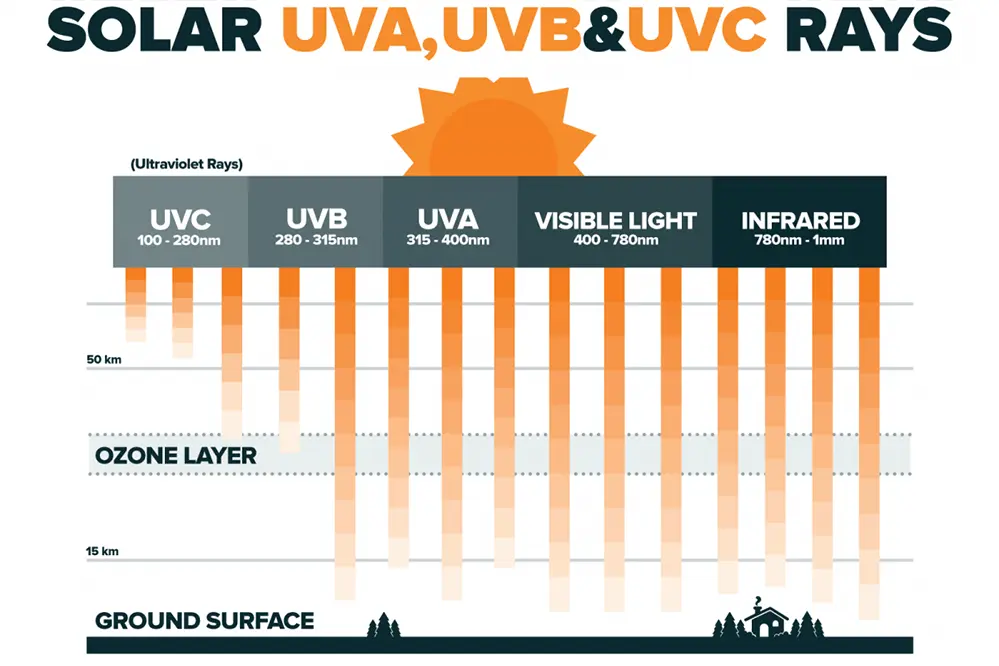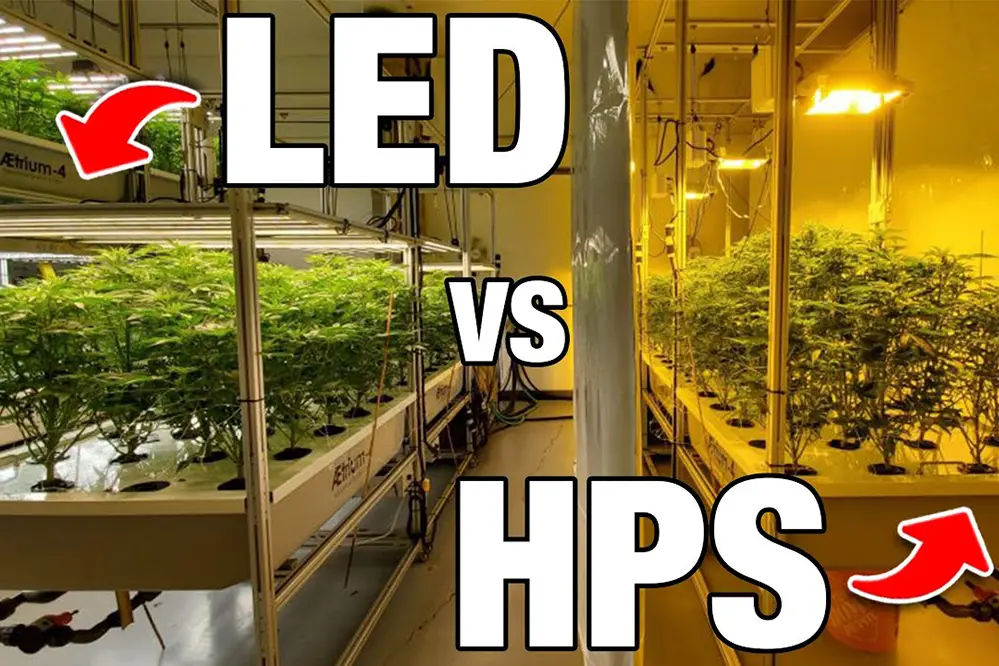In the sun-drenched summer of 1995, a young surfer named Jake learned the hard way about the difference between UVA, UVB, and UVC rays. After a day of riding waves, he found himself with a severe sunburn, puzzled by how the sun’s rays could have such a profound impact. This experience sparked his lifelong curiosity about the invisible forces of ultraviolet light.
Understanding these rays is crucial, as they play a significant role in skin health and protection. Did you know that UV radiation is responsible for approximately 90% of non-melanoma skin cancers? This startling statistic underscores the importance of distinguishing between UVA, UVB, and UVC rays. Each type of ray has unique characteristics and effects on the skin, making it essential to comprehend their differences for effective protection.
As we delve into this topic, you’ll discover not only the science behind these rays but also practical ways to protect yourself. Join us as we explore the fascinating world of ultraviolet light and its implications for your well-being. By the end of this journey, you’ll be equipped with the knowledge to make informed decisions about sun safety and skin care.
Understanding Ultraviolet Radiation
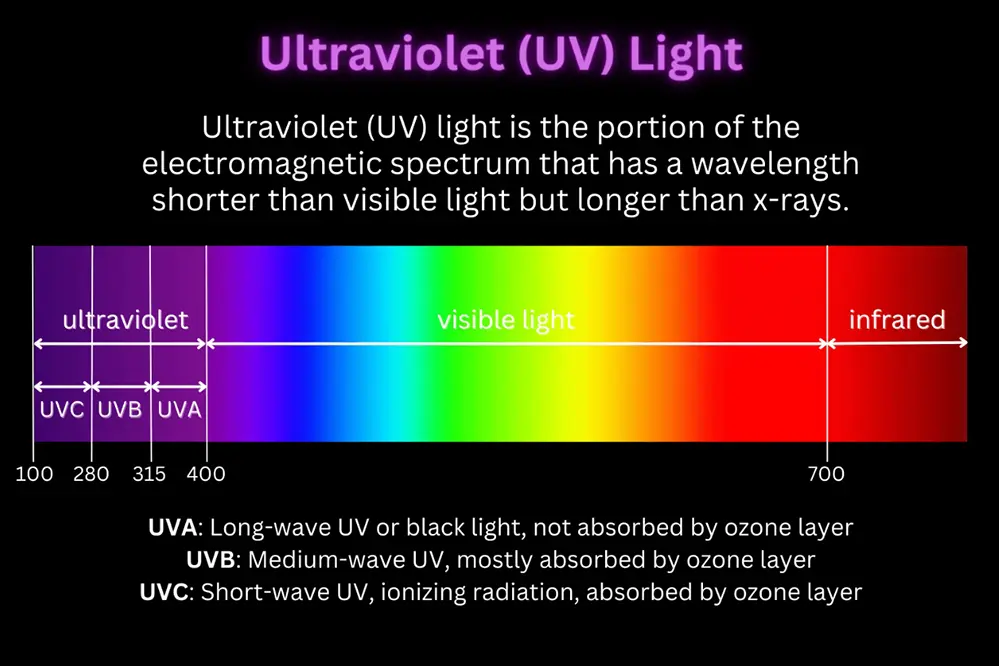
Ultraviolet (UV) radiation is a form of energy emitted by the sun, invisible yet profoundly influential on our planet’s biosphere.
At its core, UV radiation consists of a spectrum divided into three distinct bands: UVA, UVB, and UVC, each varying in wavelength, intensity, and interaction with the Earth’s atmosphere. UVA rays, constituting about 95% of UV radiation reaching the Earth’s surface, have the longest wavelengths and are known for their deep penetration into the skin. UVB rays, although partially absorbed by the atmosphere, are more intense and play a pivotal role in the production of vitamin D.
Interestingly, UVC rays are almost entirely absorbed by the ozone layer and atmosphere, thus rarely reaching the Earth’s surface. This innate barrier protects terrestrial life from the potentially harmful effects of this most potent type of UV radiation, underscoring the delicate balance that sustains life on our planet.
This careful segmentation of UV radiation into UVA, UVB, and UVC underscores the complexity yet brilliance of our atmospheric interactions, fostering a greater appreciation of how life thrives. By grasping these nuances, we take a step further in comprehending safety measures against UV exposure and the multifaceted dynamics of our planet’s atmospheric shield, encouraging responsible stewardship of our environment.
What is UVA Radiation?
UVA radiation constitutes the majority of ultraviolet radiation reaching the Earth’s surface. It has longer wavelengths compared to UVB and UVC, allowing deeper penetration, which impacts skin aging and wrinkling.
Of ultraviolet rays, UVA is closest to visible light.
Its pervasive nature means UVA rays can penetrate clouds and glass, making them a ubiquitous concern for daily skin protection. Despite their subtler effects, UVA rays contribute significantly to photoaging, the premature aging of the skin caused by repeated exposure to UV radiation.
However, this form of radiation also highlights our environment’s extraordinary capacity to foster life and adaptation through natural defense mechanisms. By understanding UVA’s role, individuals and society can better implement protective measures while appreciating the fact that every day, we gracefully coexist with the sun’s powerful energies, ensuring both wellness and vitality.
UVA’s Impact on Skin and Health
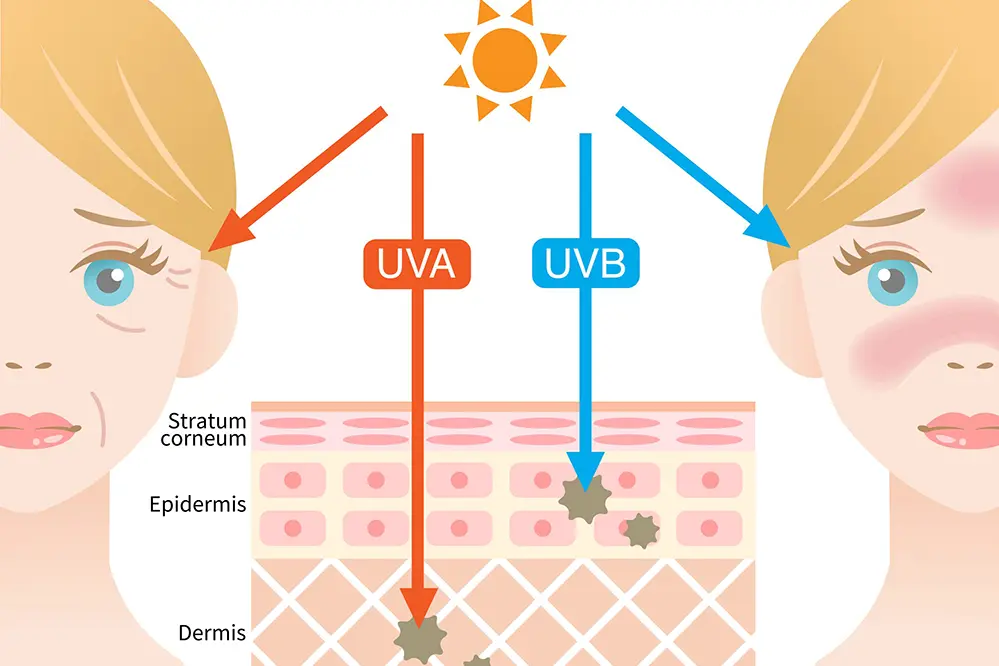
UVA rays, pervasive and penetrating, silently work beneath the surface and contribute to skin damage beyond mere sunburn.
Unlike UVB, which is primarily responsible for causing sunburn, UVA excels at silently infiltrating the skin, breaking down collagen, and accelerating the aging process through photoaging. This type of radiation plays a critical role in creating wrinkles, loss of skin elasticity, and the emergence of age spots that many strive to counteract. The stealthy nature of UVA means it is also a secondary factor in skin cancer development.
Fortunately, knowledge provides us with a powerful weapon against these invisible adversaries. By investing in broad-spectrum sunscreens that offer UVA protection and incorporating protective clothing and eyewear, individuals can significantly reduce the impact of harmful rays on their skin.
Empowering ourselves with this awareness not only encourages proactive skin health management but also serves to inspire others to join in the commitment to personal health and well-being. Through such actions, we celebrate our ability to harmonize with nature, embracing an informed approach that safeguards our future while basking in the brilliance of today’s sunshine.
What is UVB Radiation?
UVB radiation is a form of ultraviolet radiation.
It penetrates the outermost layer of the skin and is crucial for the synthesis of Vitamin D. While this might sound beneficial, too much exposure can lead to painful sunburn. Additionally, repeated exposure can elevate the risk of developing dangerous skin cancer over time.
The intensity of UVB radiation varies with the seasons.
UVB rays are stronger during midday hours – when the sun is at its highest point – and are more prevalent during the summer months, as opposed to the winter, posing a greater potential risk.
Ensuring adequate protection against UVB is paramount. By embracing effective strategies such as wearing protective clothing, seeking shade during peak hours, and choosing sunscreens that offer robust UVB protection, we can revel in the sun’s warmth with confidence. It is this informed vigilance that fortifies our skin health today and safeguards our wellness journey into the future.
UVB’s Role in Vitamin D Production
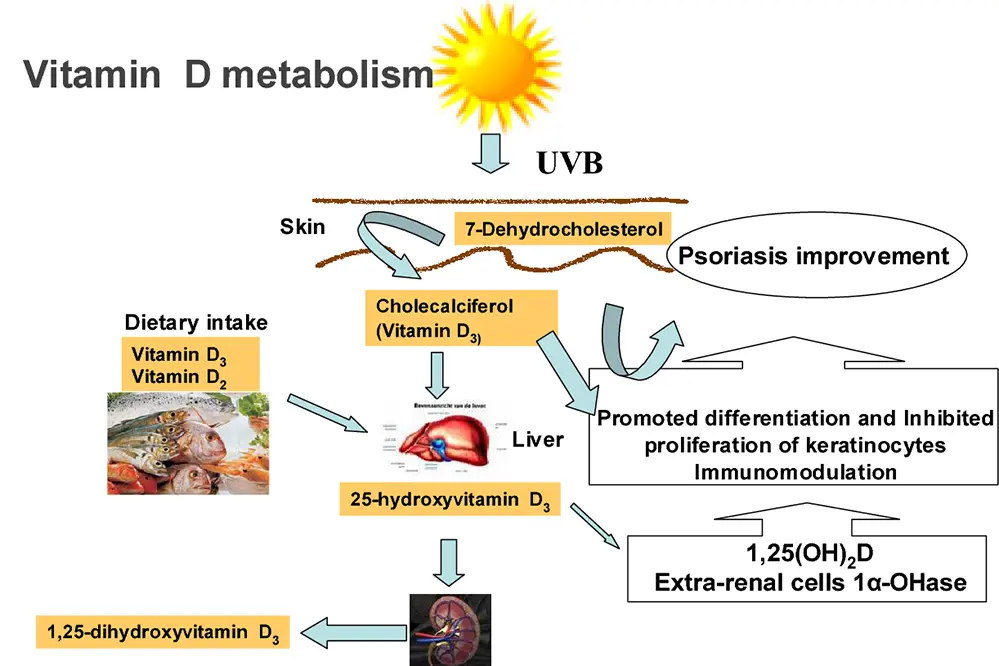
UVB radiation plays an integral role in producing Vitamin D, a vitamin vital for bone health, mood regulation, a balanced immune system, and various cellular functions, inspiring an optimistic outlook on life.
Despite misconceptions about UV radiation’s sole negative impact, UVB offers a crucial physiological benefit.
Remarkably, when UVB rays reach the skin, they initiate a chemical reaction (transforming cutaneous cholesterol into Vitamin D) that fosters health.
This synthesis leads to positive cascading effects by empowering our bones and enhancing muscle function, thereby reinforcing overall vitality.
It also encourages enhanced calcium absorption from the diet, ensuring strong bones, highlighting the extraordinary nature of UVB in facilitating processes that promote both structural integrity and energetic dynamism.
Thus, the art of balance shines brightly in UVB’s ability to enliven life. Ensuring moderation involves both harnessing its essential service and celebrating human resilience cultivated through knowledgeable engagement with sunlight’s offerings.
UVB and Skin Damage Risks
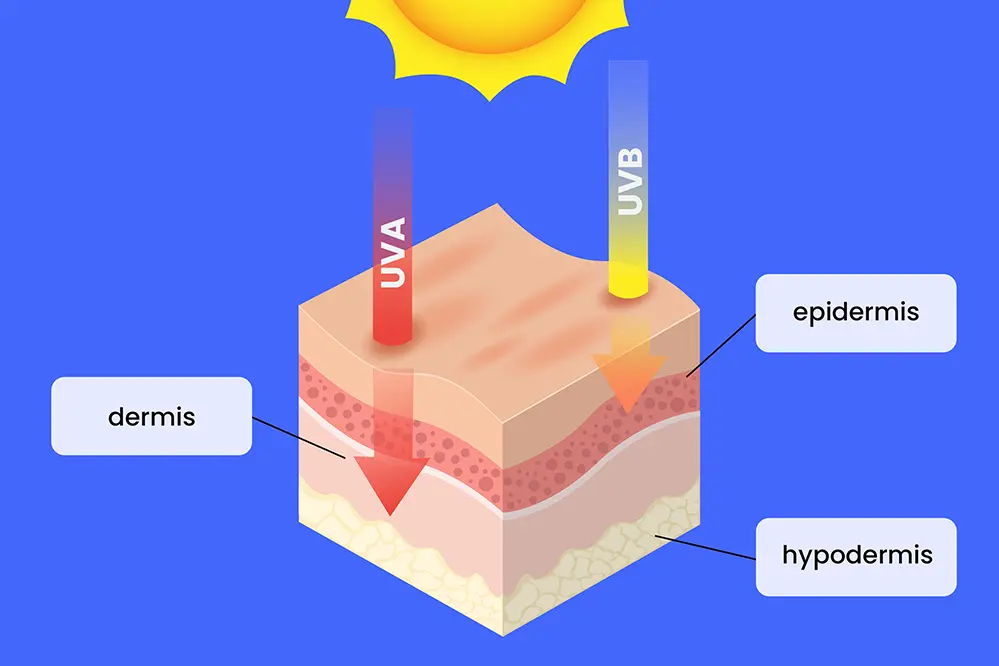
While UVB radiation presents significant health benefits, it also poses a potential danger of skin damage, underlining a nuanced relationship with these rays.
These energetic rays, which highlight the difference between UVA, UVB, and UVC, are part of the ultraviolet radiation spectrum that can cause skin reddening.
Predominantly, UVB radiation affects the outer layers of the skin, leading to sunburns (superficial but sometimes intensely painful inflammations).
Prolonged exposure may result in significant sunburns contributing to photodamage and premature aging, stressing the importance of protection.
More critically, UVB exposure is intricately linked to skin cancer risk, emphasizing the dire necessity of effective protective measures like sunscreen and minimizing peak sun exposure whenever possible.
Ultimately, the key to benefiting from UVB’s vitamin D synthesis while avoiding harm lies in finding that delicate equilibrium through informed choices and safe sun practices.
What is UVC Radiation?
UVC radiation, the most energetic and potentially harmful form of ultraviolet light, is often misunderstood.
Despite its formidable energy, UVC traditionally contributes little to sun-related skin damage due to Earth’s atmosphere.
Interestingly, the ozone layer acts as a natural, impenetrable shield, absorbing UVC and preventing it from reaching the surface.
Thus, it rarely poses a hazard to human health under normal environmental conditions, though it holds vast potential for technological applications.
In artificial settings, UVC’s germicidal properties are harnessed for disinfection, showcasing its versatile utility beyond a natural phenomenon.
The Danger of UVC Radiation
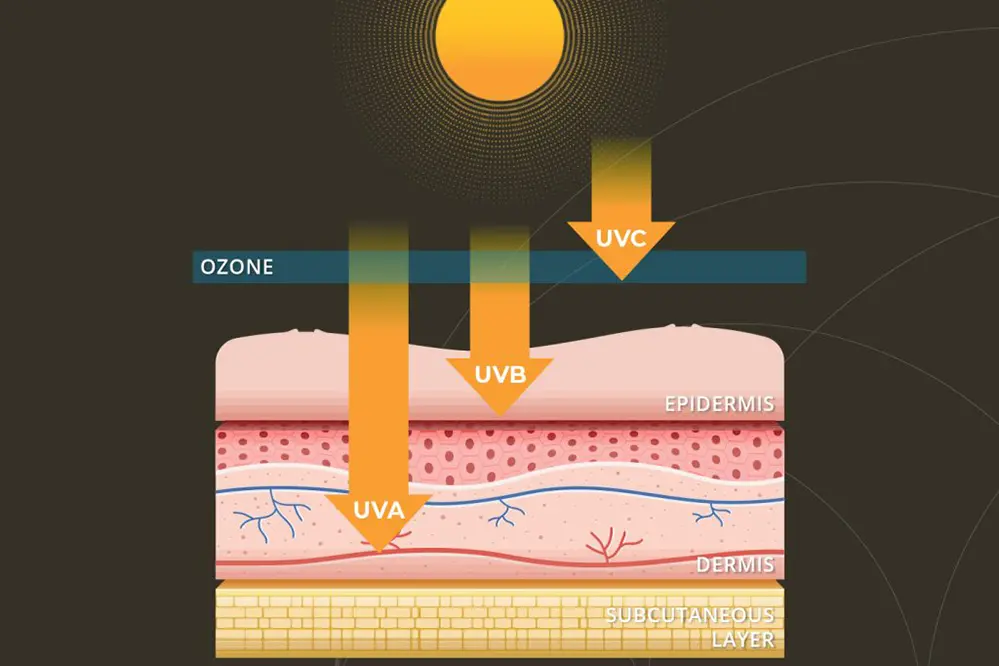
UVC radiation’s immense energy can cause significant harm, making understanding it crucial. Though rare naturally, its artificial presence introduces unique risks.
Most humans are seldom exposed to UVC radiation directly.
However, specific industrial applications can produce UVC, necessitating caution due to its powerful germicidal effects.
Unintentional exposure to UVC can result in severe skin damage and eye injuries, underscoring its potential dangers.
Anyone working near UVC-emitting devices should prioritize protective measures, including specialized eyewear and clothing, to mitigate risks.
Ultimately, the key to harnessing UVC’s benefits lies in careful management. Proper safety protocols ensure its safe use, highlighting the balance between innovation and health protection.
Natural and Artificial Sources of UV
Vitamin D, a critical nutrient for human health, owes much of its existence to the sun, our primary source of ultraviolet (UV) radiation.
The sun emits UVA and UVB rays as a part of its broad spectrum, showering Earth with the life-sustaining energy necessary for many ecological processes. As this light reaches us, it gives rise to different phenomena, encouraging everything from photosynthesis in plants to the synthesis of vital nutrients in humans. This natural UV endowment shapes our environment in ways both subtle and profound.
Interestingly, humans have mastered the art of replicating some aspects of this radiant wonder. In controlled environments, various artificial devices emit UV light to cater to specific needs, from UV lamps used to treat skin conditions and sanitize surfaces, to devices that assist in scientific research and industrial processes.
The proliferation of such artificial technologies mirrors our growing ability to channel UV into purposeful applications. While remarkable progress has been made in harnessing this energy for the betterment of society, it is paramount that we manage it responsibly. As we continue to explore UV’s vast potential, understanding and applying stringent safety measures is indispensable to balance technological advancement with public health.
Difference Between UVA, UVB, and UVC
The vibrant energy of the sun radiates as UVA, UVB, and UVC rays, each with its distinctive characteristics.
UVA, accounting for the majority of UV radiation reaching the Earth, penetrates deeply into the skin and plays a role in aging and tanning. Its omnipresence necessitates year-round protection.
UVB, though less abundant than UVA, is essential for vitamin D synthesis but can also cause sunburns and contribute to skin cancer. It is stronger during midday and in summer.
UVC is the most energetic and dangerous form, yet, fortunately, it is mostly absorbed by the Earth’s ozone layer. Human exposure primarily comes from artificial sources, like germicidal lamps.
Understanding these variations empowers us to take informed precautions, ensuring skin health and safety.
Protection Against UV Radiation
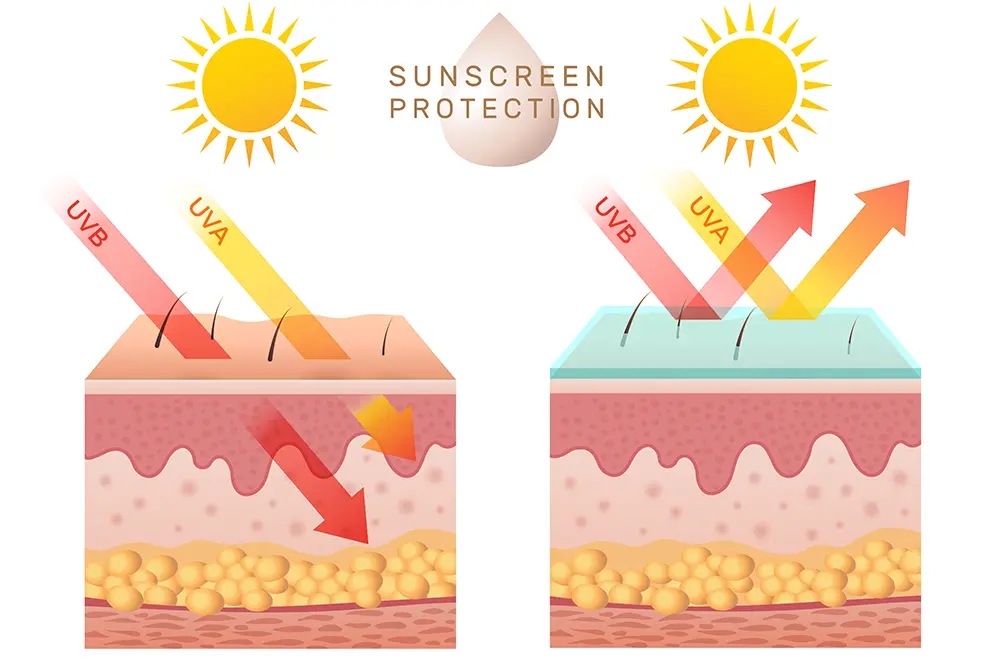
Taking steps to guard against UV radiation is essential in safeguarding our skin’s vitality. Implementing reliable sun protection strategies ensures that we remain shielded from harmful effects, fostering enduring skin health.
Sunscreen with broad-spectrum protection effectively defends against both UVA and UVB rays.
For optimal defense, individuals should choose a sunscreen with a sun protection factor (SPF) of at least 30, reapplying it every two hours, and more frequently if swimming or sweating.
Beyond sunscreen, incorporating physical barriers like wide-brimmed hats, UV-blocking sunglasses, and protective clothing constitutes an active approach to minimizing UV radiation exposure, all of which can substantially mitigate risks year-round. These preventive strategies fortify our resilience against UV’s adverse effects, reinforcing a proactive stance toward long-term well-being and confidence under the sun.
Choosing the Right Sunscreen
Selecting the perfect sunscreen is vital.
When choosing a sunscreen, look for broad-spectrum labels. This label indicates that the product offers substantial defense against diverse ultraviolet rays, safeguarding your skin. Additionally, verify if it has a sufficient sun protection factor (SPF) to ensure efficacy during exposure. Embracing these elements will enhance the sunscreen’s reliability in various environments.
Remember to prioritize UVB and UVA protection equally.
Colorants and fragrances may distract, so – for those with sensitive skin prone to adverse reactions – it is advisable to opt for formulations specifically tailored for sensitive skin types.
By understanding these pivotal aspects of selecting sunscreen, discerning individuals can effectively bolster their skin’s natural defenses, empowering them to embrace the outdoors with unshakable confidence. Utilizing the advanced selections available in the latest year will ensure a protected haven under the sun. Lean into these thoughtful choices, demonstrating a commitment to unwavering excellence in skin care safeguarding as you bask in life’s radiant adventures.
Conclusion
Understanding the difference between uva uvb uvc is crucial for effective sun protection. UVA rays penetrate deeply into the skin, contributing to premature aging, while UVB rays are primarily responsible for causing sunburn and pose significant long-term health risks. Although UVC rays are largely absorbed by the earth’s atmosphere, having comprehensive knowledge of all UV types is essential for ensuring complete protection.
Armed with this understanding, we can make informed decisions about sun protection, such as selecting the right sunscreen and advocating for enhanced protective measures in our daily environments. This proactive approach not only ensures immediate safety from harmful UV exposure but also contributes to our skin’s long-term health and resilience.
As we navigate a world increasingly aware of ultraviolet challenges, embracing innovative sun protection technologies becomes vital. By fostering a deeper respect for the powerful rays harnessed by our sun, we can confidently protect our skin and promote overall wellness. Through understanding, vigilance, and action, we stride toward a future where our skin’s resilience reflects our dedication to health and vitality.
